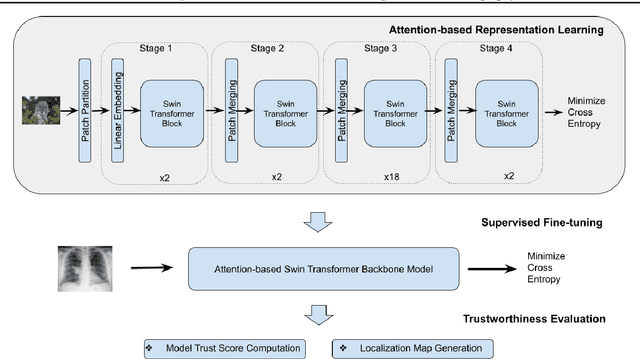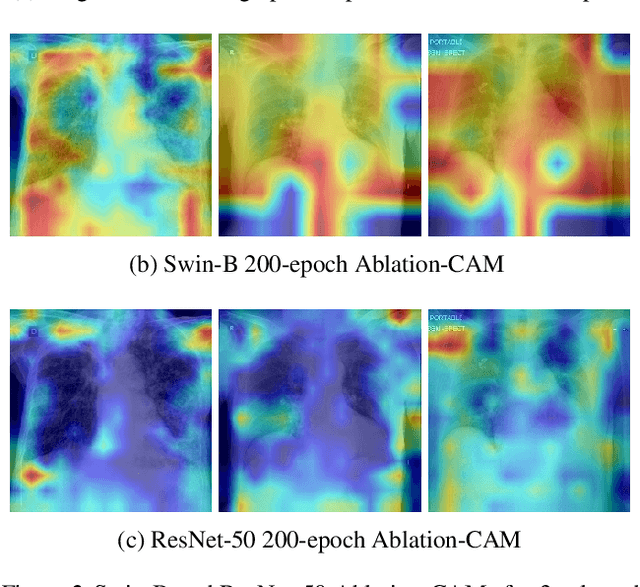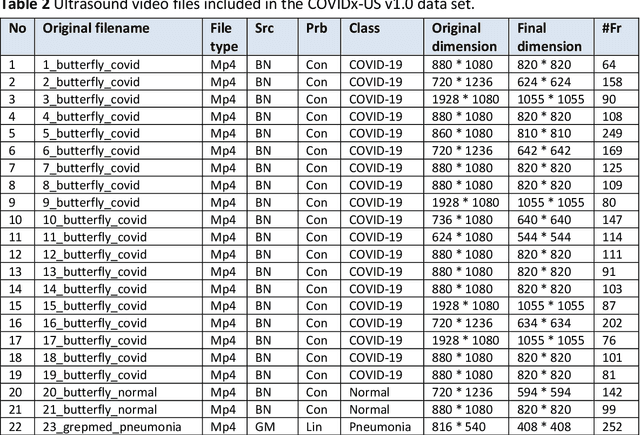Stéphane Tremblay
COVID-Net USPro: An Open-Source Explainable Few-Shot Deep Prototypical Network to Monitor and Detect COVID-19 Infection from Point-of-Care Ultrasound Images
Jan 04, 2023Abstract:As the Coronavirus Disease 2019 (COVID-19) continues to impact many aspects of life and the global healthcare systems, the adoption of rapid and effective screening methods to prevent further spread of the virus and lessen the burden on healthcare providers is a necessity. As a cheap and widely accessible medical image modality, point-of-care ultrasound (POCUS) imaging allows radiologists to identify symptoms and assess severity through visual inspection of the chest ultrasound images. Combined with the recent advancements in computer science, applications of deep learning techniques in medical image analysis have shown promising results, demonstrating that artificial intelligence-based solutions can accelerate the diagnosis of COVID-19 and lower the burden on healthcare professionals. However, the lack of a huge amount of well-annotated data poses a challenge in building effective deep neural networks in the case of novel diseases and pandemics. Motivated by this, we present COVID-Net USPro, an explainable few-shot deep prototypical network, that monitors and detects COVID-19 positive cases with high precision and recall from minimal ultrasound images. COVID-Net USPro achieves 99.65% overall accuracy, 99.7% recall and 99.67% precision for COVID-19 positive cases when trained with only 5 shots. The analytic pipeline and results were verified by our contributing clinician with extensive experience in POCUS interpretation, ensuring that the network makes decisions based on actual patterns.
A Trustworthy Framework for Medical Image Analysis with Deep Learning
Dec 06, 2022



Abstract:Computer vision and machine learning are playing an increasingly important role in computer-assisted diagnosis; however, the application of deep learning to medical imaging has challenges in data availability and data imbalance, and it is especially important that models for medical imaging are built to be trustworthy. Therefore, we propose TRUDLMIA, a trustworthy deep learning framework for medical image analysis, which adopts a modular design, leverages self-supervised pre-training, and utilizes a novel surrogate loss function. Experimental evaluations indicate that models generated from the framework are both trustworthy and high-performing. It is anticipated that the framework will support researchers and clinicians in advancing the use of deep learning for dealing with public health crises including COVID-19.
Towards Trustworthy Healthcare AI: Attention-Based Feature Learning for COVID-19 Screening With Chest Radiography
Jul 19, 2022



Abstract:Building AI models with trustworthiness is important especially in regulated areas such as healthcare. In tackling COVID-19, previous work uses convolutional neural networks as the backbone architecture, which has shown to be prone to over-caution and overconfidence in making decisions, rendering them less trustworthy -- a crucial flaw in the context of medical imaging. In this study, we propose a feature learning approach using Vision Transformers, which use an attention-based mechanism, and examine the representation learning capability of Transformers as a new backbone architecture for medical imaging. Through the task of classifying COVID-19 chest radiographs, we investigate into whether generalization capabilities benefit solely from Vision Transformers' architectural advances. Quantitative and qualitative evaluations are conducted on the trustworthiness of the models, through the use of "trust score" computation and a visual explainability technique. We conclude that the attention-based feature learning approach is promising in building trustworthy deep learning models for healthcare.
NRC-GAMMA: Introducing a Novel Large Gas Meter Image Dataset
Nov 12, 2021



Abstract:Automatic meter reading technology is not yet widespread. Gas, electricity, or water accumulation meters reading is mostly done manually on-site either by an operator or by the homeowner. In some countries, the operator takes a picture as reading proof to confirm the reading by checking offline with another operator and/or using it as evidence in case of conflicts or complaints. The whole process is time-consuming, expensive, and prone to errors. Automation can optimize and facilitate such labor-intensive and human error-prone processes. With the recent advances in the fields of artificial intelligence and computer vision, automatic meter reading systems are becoming more viable than ever. Motivated by the recent advances in the field of artificial intelligence and inspired by open-source open-access initiatives in the research community, we introduce a novel large benchmark dataset of real-life gas meter images, named the NRC-GAMMA dataset. The data were collected from an Itron 400A diaphragm gas meter on January 20, 2020, between 00:05 am and 11:59 pm. We employed a systematic approach to label the images, validate the labellings, and assure the quality of the annotations. The dataset contains 28,883 images of the entire gas meter along with 57,766 cropped images of the left and the right dial displays. We hope the NRC-GAMMA dataset helps the research community to design and implement accurate, innovative, intelligent, and reproducible automatic gas meter reading solutions.
COVIDx-US -- An open-access benchmark dataset of ultrasound imaging data for AI-driven COVID-19 analytics
Mar 18, 2021



Abstract:The COVID-19 pandemic continues to have a devastating effect on the health and well-being of the global population. Apart from the global health crises, the pandemic has also caused significant economic and financial difficulties and socio-physiological implications. Effective screening, triage, treatment planning, and prognostication of outcome plays a key role in controlling the pandemic. Recent studies have highlighted the role of point-of-care ultrasound imaging for COVID-19 screening and prognosis, particularly given that it is non-invasive, globally available, and easy-to-sanitize. Motivated by these attributes and the promise of artificial intelligence tools to aid clinicians, we introduce COVIDx-US, an open-access benchmark dataset of COVID-19 related ultrasound imaging data that is the largest of its kind. The COVIDx-US dataset was curated from multiple sources and consists of 93 lung ultrasound videos and 10,774 processed images of patients infected with SARS-CoV-2 pneumonia, non-SARS-CoV-2 pneumonia, as well as healthy control cases. The dataset was systematically processed and validated specifically for the purpose of building and evaluating artificial intelligence algorithms and models.
Understanding the temporal evolution of COVID-19 research through machine learning and natural language processing
Jul 22, 2020



Abstract:The outbreak of the novel coronavirus disease 2019 (COVID-19), caused by the severe acute respiratory syndrome coronavirus 2 (SARS-CoV-2) has been continuously affecting human lives and communities around the world in many ways, from cities under lockdown to new social experiences. Although in most cases COVID-19 results in mild illness, it has drawn global attention due to the extremely contagious nature of SARS-CoV-2. Governments and healthcare professionals, along with people and society as a whole, have taken any measures to break the chain of transition and flatten the epidemic curve. In this study, we used multiple data sources, i.e., PubMed and ArXiv, and built several machine learning models to characterize the landscape of current COVID-19 research by identifying the latent topics and analyzing the temporal evolution of the extracted research themes, publications similarity, and sentiments, within the time-frame of January- May 2020. Our findings confirm the types of research available in PubMed and ArXiv differ significantly, with the former exhibiting greater diversity in terms of COVID-19 related issues and the latter focusing more on intelligent systems/tools to predict/diagnose COVID-19. The special attention of the research community to the high-risk groups and people with complications was also confirmed.
 Add to Chrome
Add to Chrome Add to Firefox
Add to Firefox Add to Edge
Add to Edge